It’s so much fun to play with pet rats outside of their cage. They love running around, exploring new territories and being stimulated and enriched by changes in their environment. It’s our responsibility to make sure any room in which our rats play is safe. We can even tailor their play room to our rats’ specific needs and personal preferences.
Click on any of the links below to be taken directly to each topic:
- Protect your rats from these top five dangers
- How to set up your room according to your pet rats’ personalities
- Ideas for what to place inside your pet rat playroom
The Top Five Dangers
Danger #1: Electrical Cords
Whether plugged in or not, cords attached to lamps, electric clocks, stereos, TVs, computer equipment, etc, all present serious hazards. While chewing on a cord that’s plugged in, your rats can get electrocuted. Even if your rats gnaw on a cord that’s not plugged in, cords frayed and damaged by chewing are too dangerous to continue to use. Any electrical cords with exposed wiring (due to chewing) need to be replaced.
SOLUTIONS:
1. UNPLUG ALL CORDS: It’s as simple as that. If you choose to unplug, follow-through and make sure that all electrical outlets and cords are completely out of your pet rats’ reach.
~OR~
2. COVER ALL CORDS with plastic or metal tubing purchased from a hardware store or online. Even if you choose to cover cords, you’ll still want to keep an eye out to make sure your rats don’t attempt to chew through the cord covers.

Danger #2: Cracks and Crevices
Cracks under doors, gaps underneath built-in cabinets, screens in windows and heater vents are all very dangerous. Furniture often contains multiple nooks and crannies which can potentially cause injuries to your rats as well as damage to your furniture. Sofas, chairs and mattresses are all inviting hideouts and delightful hoarding spots for adventurous rats.
FURNITURE
Upholstered sofas and chairs – Your rats can easily discover an opening underneath the sofa, crawl into a tight space, (such as the arm of the sofa,) and then you won’t be able to get them out. There’s also the danger they could crawl underneath a couch cushion and get crushed if anyone were to inadvertently sit on top of them.
Mattresses and box springs – Your rats can chew into your mattress box spring and then crawl inside for a little nest building fun. This is another tight spot from which it’s impossible to retrieve your rat.
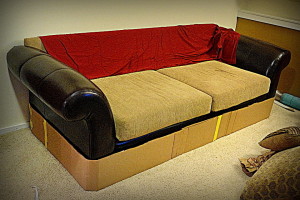
Inside both furniture and mattress box springs, there are sharp edges, tacks and other components that can cause puncture wounds.
Loungers/Rockers – If your rat were to get underneath this type of chair, your rat could easily be crushed and killed.
SOLUTION: Remove dangerous furniture or use an old sheet, bedspread or blanket to cover any furniture that could cause injury. Block off any available entrances underneath furniture. For sofas, corrugated cardboard can be wrapped around the base.
DOORS & WINDOWS
Cracks underneath doors can be extremely dangerous. This is especially true if you are in a room where there’s a door that opens to a garage or to the outdoors. If you think the crack underneath your door isn’t that large, think again. Rats can crawl under doors much more easily than you might think since they’re quite skilled at flattening themselves.
SOLUTION: If the crack underneath your door is wider than ¼”, block it off. You can do this temporarily by firmly wedging cardboard into the crack. A better, longer term solution is to install a door sweep at the bottom of the door so there’s no gap through which your rats can escape.
Sliding glass doors and windows left open with only the screen portion closed still present a possible exit for your rats. They can climb up the screen and to the side and adeptly squeeze through to the edge of the screen to the outdoors. They could also simply chew through the screen.
SOLUTION: Easy! While your rats are free-roaming, leave sliding glass doors closed. Same goes for windows—do not trust that screens will keep your rats inside. They’re too easy to chew or wiggle through.
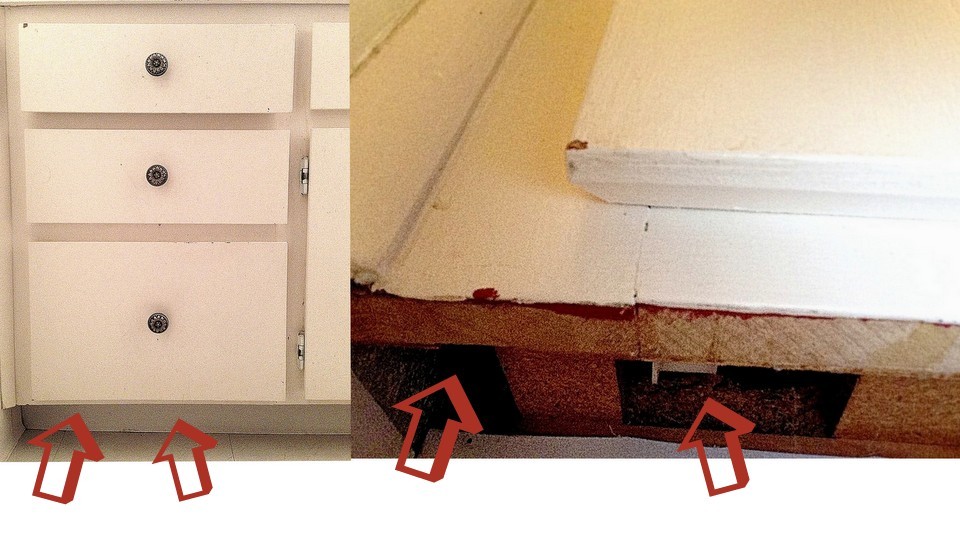
CABINETS & DRAWERS
Underneath bathroom and kitchen cabinets and drawers there are often gaps where the bottom of the cabinet meets the floor baseboard. These gaps lead inside the walls where your rat would be in danger of chewing on wires as well as getting lost and unable to return to safety.
SOLUTION: Keep in mind that there are openings underneath almost all built-in cabinet and drawers. Feel underneath with your fingers to check for openings and block them off with cardboard or anything else that will keep your rats from climbing into these holes.
Heater vents similarly pose a significant danger as they lead to inside the walls, under the floor and other out-of-reach areas of the building in which you live.
SOLUTION: Block off ANY area you don’t want your rats to go and/or that could cause danger if your rats were to enter.
Danger #3 – Stringy, dangling window curtain or blinds cords, fringe on curtains, bedspreads or blankets
Rats enjoy playing with stringy things—very similar to cats. If not closely supervised, rats can get tangled, choked or lose circulation resulting in the loss of a limb.

SOLUTION: It’s best to not have anything with fringe or anything “stringy” in the room unless you’re with your rats and playing with them with the string. For window blinds or curtain cords, you’ll want to make sure they’re out of reach.
Danger #4: Toilets
If your rat were to jump up onto a toilet then fall into the bowl, there’d be no way for him to get back out and your rat would drown.
SOLUTION: Whenever your rats have access to a bathroom, always keep the toilet lid closed!
Danger #5: Garbage cans
Rats love to get into garbage cans and explore what’s inside. This may result in their eating something that’s harmful as well as their not being able to get back out once they’ve gotten inside a garbage can.
SOLUTION: Either remove garbage cans from your rats free roam room, place them up high and out of reach or keep them securely covered.
Making a room safe according to your rats’ personalities
Here are 4 personality types around which you can customize their room. (Click on each type to go directly to that section.)
- Chewers (see below)
- Climbers
- Jumpers
- Urine Markers
Chewers
Besides the potential of your rats being injured, electrocuted or poisoned by chewing, your belongings can also be significantly damaged. Chewers will gnaw on paint, wall plaster, wood baseboards, furniture, books, bugs, papers, upholstery, carpet, bedspreads, plants, electrical cords (unplugged or not) and just about anything else they can sink their teeth into.
SOLUTIONS:
- Use the solutions listed earlier for how to protect cords and furniture.
- Provide a wide variety of chewing toys (specifically made for small animals) and place them throughout the room.
- Whenever possible, use behavior modification to work with your rats. This is important especially in the beginning when your rats first start exploring a room. Rats are highly intelligent and trainable. When they chew on something they shouldn’t be chewing on, make a special sound reserved only for when they’re doing something you don’t want them to do. (I make a clucking sound in the back of my throat.) You can also say their name in a stern voice so they know you see what they’re doing and that you don’t approve. It’s important to then immediately redirect them to chew on something that IS appropriate such as various wooden chews made for small animals or a lab block. (Make sure to have these readily available in various areas of the room.)
- Many house plants are toxic to rats if ingested. Keep house plants out of reach or out of the room completely.
- Dust and vacuum regularly so there aren’t bits of old food, miscellaneous types of paper, dead bugs or anything else that can end up in the carpet.
- Cover upholstery and beds with old sheets or blankets. This not only deters chewing but also protects from odors and stains caused by urinating, defecating or marking behaviors.
- In some instances, Bitter Apple or a similar product can be applied to the area where your rat is attracted to chew. This type of product can be found online and in most pet stores. It works especially well on wood or walls in your room, although not all rats are deterred by this sort of product. It is better to train them as mentioned above and to switch their attention to a chew toy that’s safe for them to chew on.

Climbers
Some rats are expert climbers. They climb curtains, bookshelves, towels hanging from a towel rack, sides of shower doors, and even chest of drawers by using the drawer pulls or handles as a ladder. Once they’ve climbed as high as they’d like, they usually have no way of getting back down safely.
SOLUTIONS:
- If you do allow your rats to go onto shelves or ledges (or anywhere high up) you must be right next to them and ready to catch them if they start to fall.
- Or, better still, close off access to anything your rats can climb up. You’ll get ideas of what needs to be off-limits when your rats initially begin to explore the room. You’ll be surprised at what they’ll find to climb.
- Create safe climbing areas so they can still use their mountaineering skills. Check out the sloping, fabric-covered climbing wall on the right side of this indoor pet rat playground.
Jumpers
Also common for some pet rats is jumping. Rats will, for example, jump from a table to a bookshelf and then on up onto the next highest shelf. Some rats will attempt to leap from the arm of a chair onto, say, a picture frame. This is dangerous because rats can easily fall from great heights and become seriously injured. Bruising of internal organs, broken bones and even death can result.
SOLUTIONS (Similar to Climbers): If your rats are jumpers, keep an eye on them at all times especially when they first start to explore a new room. After awhile you’ll be able to tell what appeals to your rats the most. Then you can either move around the furniture and any other jump-off areas or you can make sure you’re on hand to assist (and prevent dangerous leaps) at all times.
Urine Markers
Most urine markers are male rats. They’ll dribble small amounts of urine here and there, marking their territory.
SOLUTIONS:
- There’s a possibility you can use behavior modification and divert their marking behavior. Do this by having litter boxes available outside the cage. Place your marking rat directly into a litter box as soon as you take him out into the play room. This reinforces where you want to see him urinate. Also, if you see your rat about to mark an object in the room, immediately place him in the litter box.
- Having males neutered can also often help reduce or even eliminate urine marking.
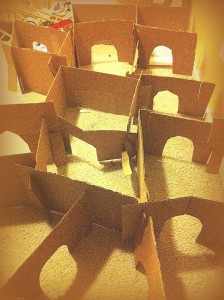
Tips for Making Your Safe Rat Room a Better Place for All
It’s ideal when the room in which your rats roam is also the room where their cage is located. While they’re out you can leave the cage doors open should they want to return home at any time.
Many rats will go back inside their cage to defecate and urinate. Initially, however, it’s a good idea to place litter boxes in all corners of the room in which they’ll be playing. After awhile, if you find they only use the bathrooms inside their cage, then you won’t need to place additional litter boxes in the room.
If you find they do urinate and/or defecate when outside their cage, they may choose to use areas other than just the corners of the room. Whenever you find they use any area as a bathroom, place a litter box there and they’ll get the idea. Also, if you see them just about to urinate or defecate when they’re not in a litter box, gently move them immediately to the nearest litter box.
Before allowing your rats to roam free in a room, it’s important to dust and vacuum and to do so on an ongoing basis. Rats will eat just about anything they find on the floor including insects, old and moldy bits of food and various types of paper all of which could cause your rats to become injured or ill.
In general, and especially in the beginning stages of allowing your rats out in a room, observe them very carefully to see what they might start to get into that could be dangerous. Sometimes you won’t even realize something could be dangerous until you see your rat begin to explore an object or area that could cause harm.
There are times when I find there’s a part of a room in which I don’t want my rats to go and it’s difficult to block it off. When this happens, I place one or more plastic or paper bags in that particular place. That way I can hear the bag(s) “crinkle” when they go into that area and know to either monitor closely or remove my rats right away. (As you can see, this trick can only be utilized under close supervision.)
Helpful Items to Have in Your Rats’ Room
The more fun things you have for them to enjoy while they’re out in their room, the less chance your rats will get into trouble. Here’s a short list to get you started:
- Food and water (inside and outside the cage—your rats will especially enjoy discovering there are bowls of water left around the room from which they can sip)
- Tubes, pipes, and/or large paper mailing tubes
- Wheels
- Boxes
- Ladders
- Food Puzzles (after clicking on this link, you’ll find food puzzle links listed below the video)
- Build a maze
All of the above may seem like a lot to prepare and watch out for at first. After awhile, though, you’ll find it’s easy to maintain a safe and fun play room for you and your rats.
updated 4/10/23


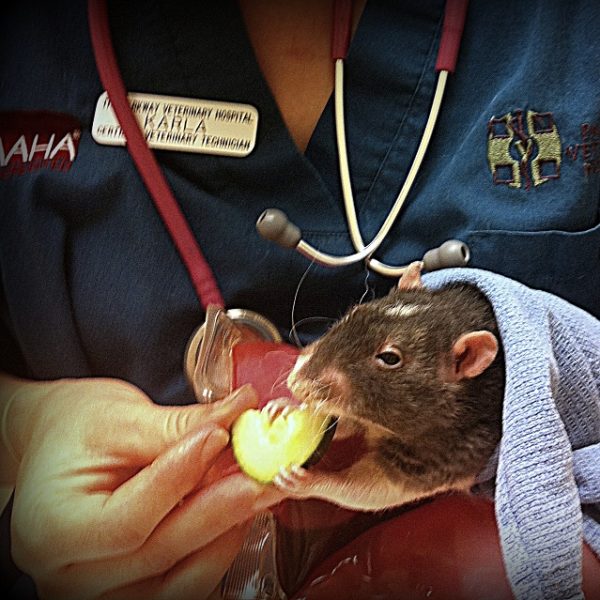
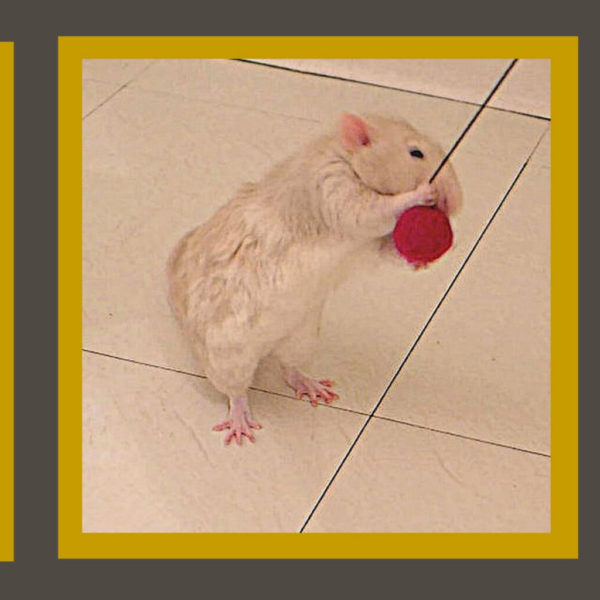



OMG!!!! I love rrats thank youu SOOOO much for providing this information to me!!! I really enjoyed reading up on this so I can better care for my RATS!!! Perchance. Maybe I could donate to help you guys out! You guys are a non-profit right? If so I’d like to donate so YEAH!!!! RATRATRATRATRATRATRATRATRATRATRATRATRATRATRATRATRAT.
Thank you so much for your positive feedback. You sound like a wonderful pet rat caretaker. I’m so glad my site is helpful for you. I’m working on getting a donation button set up on my website. As soon as it’s available I’ll email you to let you know.
Besides donations, it’s helpful if you ever want to buy any of the products linked to on my website. I receive a small commission at no extra cost to you when you purchase anything after clicking on a link. Also, if you sign up for my email list, you’ll be given a link to Essential Pet Rat Supplies which also includes affiliate links that help out About Pet Rats.
Let me know if you have questions anytime. Thanks again for your comment and positive feedback.
Best Wishes to You & Your Rats,
Jasmine | About Pet Rats
I’m finding this page 3 years later so I hope it’s still active! I recently rescued 2 girls who are pretty timid. They’re coming around slowly (one let’s me semi pick her up while she’s licking treats off my hand the other will lick treats off my hand but we haven’t gotten to the pick up stage yet.) I can tell they’re curious and want to explore outside the cage as they will come to the front and hang their body outside, but unfortunately my house is open concept and there is no possible way for me to let them free roam in the space where their cage is. I’d like to free roam them in the bathroom and I’ve rat proofed it! I’ve had them for a week and have yet to take them out of their cage, I have had my hands in there for hours everyday though lol! They’re pretty fast and jumpy so I’m nervous about taking them out of the cage for the first time as I’m worried they’ll hop out of my bonding pouch! I’m looking for advice on how to approach this situation as I’m a first time rat momma and want to do this right, but I feel like I’m not doing it right as I haven’t taken them out of the cage yet!
Hi Ali,
I completely understand where you’re coming from regarding wanting to make sure you’re “doing it right”. It sounds like you’re off to a great start. I love hearing that you are going slow and understanding that it’s a gradual process having your rats get used to being with you. That’s also great that you’ve rat-proofed your bathroom.
I suggest you read Bonding with Your New Pet Rats. Another post you may find helpful is How to Transform Your Rat: from shy to social butterfly. Both of these posts will give you ideas on how to develop your relationship with your rats and how to acclimate them to being outside their cage.
If you still have questions after reading the articles mentioned above, don’t hesitate to let me know.
I’m excited for you having your first pet rats. They are the most amazing pets and I know you’ll all enrich one another’s lives.
Best Wishes to You & Your Rats,
Jasmine | About Pet Rats
I was wanting to take my rats outside,but not outside outside. they sometimes jump out of the playpen, so I was wondering if a tent would work.
Hi There!
Having your rats outside while inside a tent is fine…as long as it’s not super hot or cold outside. I have taken my rats camping with me. While I was asleep, though, I kept them in a small cage inside the tent.
You’ll want to watch for any chewing on the tent. I would definitely advise being with them whenever they’re inside the tent. It’s too risky to leave them in there without your supervision.
Thanks for your great question!
Best Wishes to You & Your Rats,
Jasmine | About Pet Rats
I have 3 rats named Winnie, Smudge, and Gus-Gus, and they love being outside the cage, but the room their cage is in isn’t super rat-proof, so I can’t just let them walk around, and the alternative (carrying them around/shoulder rides) works with each individual rat but not if I want them all out at once. Winnie is a chill little girl who will calmly sit on my shoulder, but Gus-Gus is a very jumpy boy who will leap off my shoulder and Smudge is an old girl with partially paralyzed back legs and trying to carry them all at once is basically a juggling act. Recently I’ve been looking into ways to rat-proof the room the cage is in and this post gave some of the best advice I’ve read during all my research. I’m super excited to get the room to a place where they can have a safe free-roam without me worrying about them. Being outside the cage is genuinely Gus-Gus’s favorite thing ever; he would go everywhere with me if he were allowed, so I know he will be happy to be able to run around and play with the others outside the cage. Your site is really helpful, especially with all the DIY rat stuff tips since I love making things.
Hi Ada,
I’m so glad you found my page on rat-proofing a room to be helpful. It’s my biggest passion to help people learn about caring for their pet rats. Thank you for letting me know you’re finding my website to be useful. I really appreciate your feedback.
I can see what you mean about it not being easy to have all 3 of your rats out on your shoulder at the same time. Winnie, Smudge and Gus-Gus each have such different capabilities and needs.
That’s so great you’ve been working on rat-proofing a room so they can all free-roam safely together. I’m impressed by your dedication to figuring out new ways to help them all live fulfilling lives. It always makes me so happy to know there are people like you out there, researching how to make your pet rats’ lives the best possible.
Keep up the great work! Don’t hesitate to ask me any questions any time.
Best Wishes to You & Your Rats,
Jasmine | About Pet Rats
I’m doing research and trying to decide if I’m going to get a rat now if I were too get one and I have a fish tank about 3 feet of the ground would a rat be able to jump on it while exploring? Also I have been looking at you’re blog love the habitat part thanks for all your helpful tips also which gender would be better if I want a more sweet and a couch potato? Thanks 👍
Hi Cat,
Some rats can jump pretty high. Especially young females. I’ve had many female babies jump from the bathroom floor onto the top of the toilet seat. (…which is why the toilet seat should always be closed when rats are around….and which is why you should always supervise rats, anyways, when they’re out of their cage.)
Boy rats are definitely much sweeter and more couch potato-ish. This is, of course, a generalization. I myself haven’t ever had a mellow female (in over 30 years), though. Girls are always busy. They have things to do and usually don’t want you interfering. Male rats can be super cuddly. (….which is why they’re my faves.)
You mentioned you were thinking of getting “a” rat. I just wanted to make sure you know it’s best to have at least two rats?
In any case, it sounds like you’re doing some excellent research and planning. Let me know if you have any other questions any time.
Take Care,
Jasmine | About Pet Rats
I’m glad I could help! :D I’ll keep those ideas in mind for providing steps for them to go down. Haha they are certainly determined to do things their own way! Lucy had a fright when she slipped once but it hasn’t deterred her one bit. I had an idea of putting ledges all the way diagonally down the sides but that would cost a small fortune! If only I could figure out how to attach fleece blankets around the sides so that if they fell they’d land on them.
Oh my goodness you must’ve been scared when your rat was in the walls! I’d be terrified they’d chew the wiring too!
Thank you for considering my idea for an article. I’ll look forward to seeing what you come up with in the meantime :D
Yes I like to have a wide variety for my girls to choose to play with that I rotate around weekly. They get lots of different hammocks and beds to choose from ( I’ve noticed that they like to swap beds during the day and they don’t always sleep together XD), cardboard boxes, chew toys, lots of ladders, shelves & ledges, food bowls, foraging toys, bird swings, ropes, hides, tunnels, plastic hanging baskets and balls. They also have a dig box and an exercise wheel. Of course the hardest things to store are the biggest like the hides, wheel and the cardboard boxes, but the igloo-type beds are the worst to store because they lose their shape from being squashed under all the other beds. Then without some sort of system everything keeps getting mixed up, I keep forgetting where everything is supposed to go lol.
I could probably go on for ages about storage problems haha, there’s also all the grains, seeds, herbs, supplements ect. ect. as you can probably tell most of my bedroom is basically just rat supplies lol!
I did think of a great way to store the hammocks the other day, attach them to coat hangers with some shower curtain rings; and hang them on a rail in the cupboard, it works a treat!
Thank you for your kind reply, sorry for my rambling one!
All the best to you and your rats!
Emma & Georgie, Lucy and Alice
Hi Again Emma!
I love hearing all of the different toys and things you’ve been rotating in your rats’ cage. It sounds like you have a great collection. You and your rats are fortunate to have found one another. :)
That’s a fantastic idea to store the hammocks by attaching them to coat hangers with shower curtain rings and then hanging them on a rail in the cupboard. I have a plastic “chest of drawers” in a closet that I use for storing rat supplies. It’s so hidden away, though, that I often forget I have stuff in there.
How to store rat toys/supplies is a great idea for a post in the future—I really appreciate your suggesting it. Maybe I’ll ask readers for their input.
Thanks again for your comments, suggestion and sharing what you provide for Georgie, Lucy and Alice.
Best Wishes to You & Your Rats,
Jasmine, Justine & Geronimo <3)~
My rats are definitely climbers and jumpers and I have to watch them all the time while they’re out. The biggest issue is actually that they love to climb up their cage and run around the top but have trouble getting down. Their cage is quite tall and I constantly have to hold my arms underneath them encase they fall. Alice learned this pretty quickly and now she climbs up and then waits for me to lift her down! XD
One time I forgot to block off the wardrobe, and I turned around to see two tails disappearing behind it!!! It gave me such a fright but they came back straight away and I was able to block it off!
Could you do an article on storing rat toys? I am constantly having trouble finding space to store the bulky items etc. :D
Hi Emma,
Thanks so much for your comment. That’s a good point about rats climbing to the tops of their cages. Mine do that too and I didn’t even include it in my article! I’ve had some rats I could train to come down from the top of their cage. I set up ladders that would go from the top of the cage to a chest of drawers, then from the chest of drawers down to the seat of a chair and from the seat of the chair to the floor. But some rats just want to do it THEIR way even if you set up a safe way for them to get down. I’m so glad you brought that up, though. I’ll have to include that the next time I edit this post.
That’s great that Alice waits for you to lift her back down when she climbs to the top of your rats’ cage. My current 2 rats also climb to the top and then wait for me to take them back down. Alice is a fantastic rat name, by the way!
Good to hear you were able to block off the wardrobe in your room. Also, thank goodness your rats came out straight away.
I once had a rat climb into the walls by getting in underneath a bathroom counter. It was a brand new rat and I didn’t even know there were holes down there. That’s why I made sure to include that there are almost always openings that lead into walls underneath cabinets found in bathrooms and kitchens. My rat took hours before it came back out. I was worried it wouldn’t come back but thankfully it did.
I will put it on my list to write a post about storing rat toys. Thanks for suggesting it. It may be a little while before I’m able to get to it, but it will definitely be on my “to do” list! Do you rotate your rats’ toys and that’s why you need to store them? I’m also curious about what types of toys you’d like to store.
Thanks again for commenting. You sound like a great rat caretaker.
Best Wishes to You & Your Rats,
Jasmine | About Pet Rats